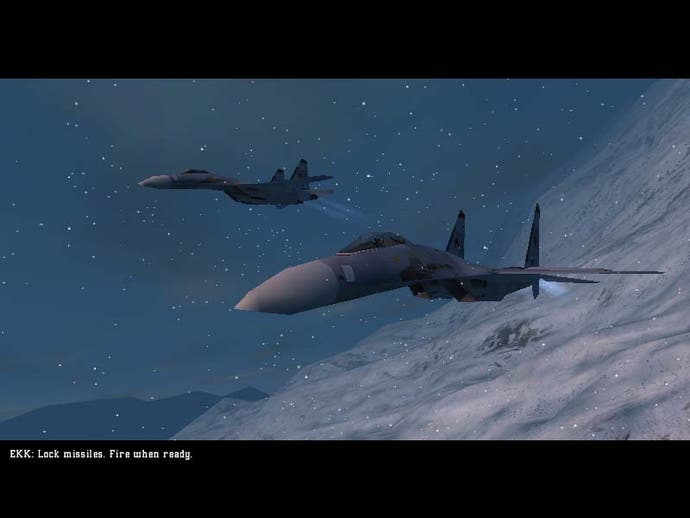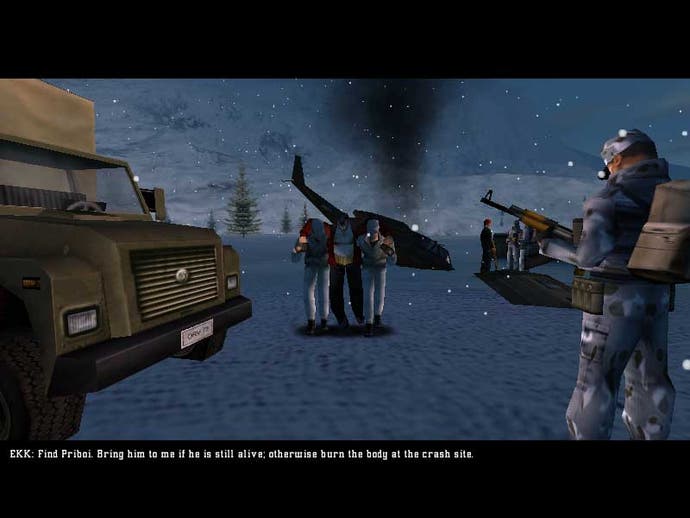Project IGI
Review - another top FPS title for the turn of the millenium

Back to reality
Quite how long the realm of reality can be plundered and stuffed into the first-person shooter genre in various guises is something critics have been pondering over for a while now. The idea of experiencing a game from the eyes of a pre-determined character with a gun strapped to their chin is growing all the more stale, and the quest for originality has been significantly dampened throughout the course of only a couple of years. Of course, there are a few innovators every so often that tend the break the mould and set landmarks for all developers to aspire to; Half-Life, Thief and Deus Ex are just a few such titles. So then, it would come as quite a great surprise to find that one of the newest innovators of the genre happens to be a Norwegian outfit called Innerloop, previously recognised for an acclaimed flight-sim released three years ago called Joint Strike Fighter. On first impressions, you'd be forgiven for mistaking IGI for yet another bandwagon-jumping realism-fest, in the same vain as Rogue Spear or Delta Force, yet Project IGI's success lies in its subtleties. Project IGI's plot (IGI stands rather cheesily for "I'm Going In", by the way) is set in the former Soviet Union where the game's protagonist, David Jones - an ex-SAS soldier turned freelance Allied governments operative - is tracking down Jach Priboi, the man responsible for the theft of a nuclear device. As Jones finally manages to hunt down Priboi, he learns of the buyer of the weapon and what their plans are for it. Although the game takes a fairly linear mission-by-mission approach, the unfolding storyline lends the game a narrative credibility not usually associated with this kind of structuring.

Vast
The first thing any player will notice about Project IGI is the sheer scale of the levels, clearly the result of its flight-sim heritage - the playing field is literally vast and would take an absolute age to find the edge of, if you were inclined to do so. The foreboding sense of abandonment and isolation in a hostile environment sets in from the very start of the game, and it doesn't let up until the very last showdown. To the developer's credit, the structures and buildings dropped in the middle of these huge expanses are fabulously designed and serve to force claustrophobia down your neck when appropriate - the blind panic induced when an alarm is set off and you're stuck inside an installation is wonderfully effective. Although the missions all take place in the wilderness away from any discernible kind of civilization (as opposed to the mostly urban scenarios which seems to be de rigeur for the genre), the actual installations and scenery you come across varies to a pleasant degree, from a burnt out village in a mountain range to a sprawling train yard set in a deep valley. On the various occasions where you may be roaming at a high-altitude - for example in a sniper tower or atop a hill - you realise the true beauty of the game… it almost brought a tear to my eye. Not really. But you get the idea. Aiding your progress through most of these missions is an all-star cast of weapons and intriguing gadgetry. Often you will start a mission with a relatively small armoury composing of a machine gun, pistol, knife, and perhaps a medipack, though you're likely to pilfer extra weapons from the opposing forces and their weapons caches during your mission. Accompanying the weapons are your tactical aids in the form of an excellent pair of night-vision enabled binoculars with an incredible range on them, and a real-time GPS map, which utilises the game engine so you can zoom in and spot guard patrol routes and possible entrances. IGI is one of the rare occasions when such tools come in handy and are used often, as planning and the casing of your objectives is heartily recommended for success. Occasionally you can come across a medipack, but instead of healing a set amount of health points regardless of your current status, you can administer the healing yourself via a syringe whenever you think it appropriate. This keeps the realism and arcade sides of the game in a nicely balanced harmony.

Licensed to Spoil
Despite being a truly astounding game, it's only natural for it to have its faults and when IGI trips up, it does it in a big way. Perhaps the largest setback which would put the majority of the paying public off is the omission of an in-game save feature, as your progress is only recorded once a mission is complete. Now personally, this only really poses itself as a problem in the later stages of the game, where missions can become so large and complex it is an immense chore to have to begin a mission again. Frequently I would quit after one go just because I couldn't be bothered to trace over my footsteps again - this was just on Easy mode as well! A patch to insert at least a limited save feature would be most welcome; even just two saves per game would serve as a bonus. The level design, although generally brilliant, falters here and there because after the first couple of levels, you begin to realise that a lot of buildings are pre-fabricated and literally cut-and-pasted around the levels. Towards the end of the game, going through apparently the same buildings over and over begins to grate, and I can't honestly see how the developers could have been so lazy. The AI, too, often leaves a little to be desired; for example you have two guards standing side by side. You pop one fellow in the back of the head and he drops to the ground with a yelp, yet his buddy will happily stand there gazing into the distance for you to remove the back of his skull as well. And the enemies don't react terribly well to sound either; you can, for example, often get away with firing an AK47 (a horrendously noisy weapon) in close proximity without guards noticing.

Norman No-mates
Whilst playing IGI, I was consistently aware of the fact that it reminded me of something from gaming past… another truly great game. My realisation of what this was only towards the end of the game, when it suddenly dawned on me that I was basically playing a fabulous PC rendition of the N64's GoldenEye, albeit with bells on. All of a sudden it became clear, and not just in the game mechanics - the sniping hunts in snow storms, the assaults through underground tunnel systems, the picking off of scattering guards as they sprint for the alarm switch - it all came flooding back. The thing is, I don't ever recall Innerloop citing Rare's masterpiece as an influence, but I'd find it extremely difficult to believe that it isn't to be credited somewhere in IGI's creation. This thought led me to conclude what is undoubtedly Project IGI's greatest faltering - its lack of multiplayer. Honestly, I believe that the game's life could be extended a hundred-fold with the ability to play others in what could have been a serious contender to Counter-Strike's crown, and it is indeed a great shame that this hasn't happened. It just stands as a dream for the already burgeoning IGI community that perhaps a future patch could rectify this frankly horrendous oversight.
Conclusion
Project IGI is a must-have purchase for any action gaming fan, and is a testament to what can still be done with the genre with the proper amount of thought. However, the issue of longevity does come into play with the omission of a multiplayer mode, and as such it's far from what it so easily could have been.

